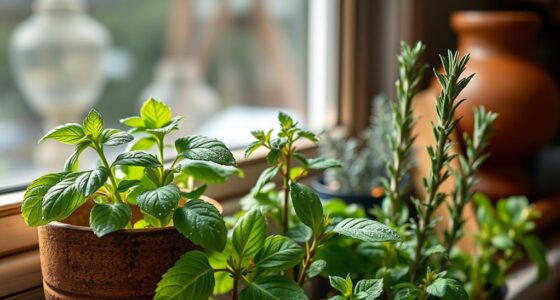To spring clean your indoor garden, start by dusting and wiping plant leaves to boost photosynthesis and keep them vibrant. prune any dead or damaged foliage to promote healthy growth. consider repotting if roots are crowded or soil is old, and clean your pots and surrounding surfaces. adjust your lighting and watering routines to seasonal needs, and fertilize to encourage lush new growth. Keep at it, and you’ll uncover more tips for a thriving, refreshed indoor garden.
Key Takeaways
- Dust and wipe plant leaves regularly to remove dust, improve photosynthesis, and maintain vibrant foliage.
- Prune dead or damaged leaves and overgrown stems to promote healthy growth and prevent pests.
- Check roots annually, repot if crowded or root-bound, and use well-draining soil for optimal health.
- Clean pots, saucers, and shelves to prevent mold, pests, and debris buildup, ensuring a clean growing environment.
- Adjust watering and lighting routines to match seasonal changes, promoting strong growth and overall plant vitality.
Dust and Wipe Your Plant Leaves
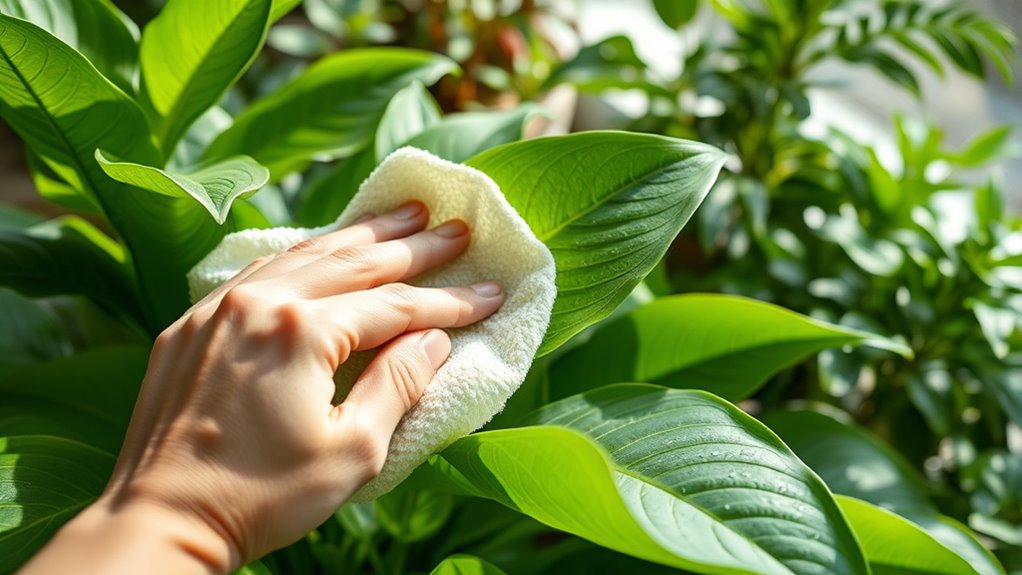
To keep your indoor garden healthy, it’s important to regularly dust and wipe your plant leaves. Dust can block sunlight and reduce photosynthesis, so gentle cleaning is key. Incorporating innovative materials into plant care routines can further improve overall plant health and resilience. Use a damp microfiber cloth or soft brush to carefully remove dust from large, glossy leaves like Monstera or Fiddle Leaf Fig. For fuzzy or hairy foliage, opt for a soft paintbrush or a damp cotton swab to avoid damaging delicate hairs. Wiping leaves at least once a month helps prevent dust buildup and keeps your plants looking vibrant. When cleaning, avoid leaf shine products, as they can clog pores and hinder respiration. If dirt is stubborn, rinse the leaves with lukewarm water and a small amount of mild dish soap, then dry with a soft cloth to prevent water spots. Regular cleaning can also help identify signs of pests or disease early, ensuring your plants stay healthy. Additionally, paying attention to plant care technology can optimize your maintenance routine and promote robust growth. Incorporating AI-driven data analytics can help you monitor your plants’ health more effectively and adjust your care practices accordingly.
Prune and Shape Your Plants
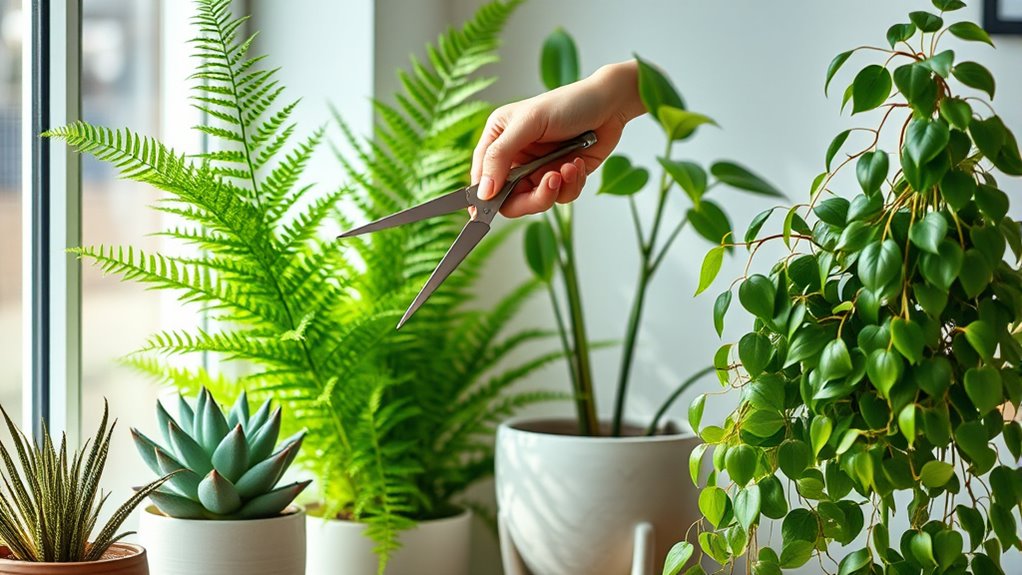
Start by removing dead, damaged, or diseased leaves with clean, sharp shears to promote healthy growth. Trim overgrown or uneven stems to keep your plants looking tidy and prevent them from becoming leggy. Shaping your plants enhances their appearance and ensures proper light and airflow within the foliage. Incorporating diverse plant designs can also help achieve a more balanced and attractive indoor garden. Additionally, regular pruning can help prevent pest infestations and encourage new growth.
Remove Dead or Overgrown Foliage
Have you noticed any yellow or brown leaves on your indoor plants? Removing dead leaves is essential for good plant care. Use sharp, clean scissors or pruning shears to make clean cuts just above a node or leaf axil.
Pruning dead or overgrown foliage helps direct energy to healthy growth and prevents disease or pest issues. Clearing away yellow, brown, or damaged leaves also keeps your plants looking tidy. Proper plant maintenance is key to a thriving indoor garden. Incorporating natural materials like wood or stone in your plant containers can enhance the rustic charm of your indoor space.
Regular pruning and shaping promote bushier growth and enhance the plant’s overall robustness. By trimming selectively, you maintain your indoor garden’s desired size and appearance. Using self watering planter pots can help maintain consistent moisture levels, reducing the need for frequent pruning caused by drought stress. Additionally, choosing performance upgrades for your gardening tools can improve precision and ease during pruning activities. Incorporating high-quality, durable tools similar to safety and durability considerations in wooden toys can make your gardening experience safer and more efficient.
Maintain Plant Symmetry and Shape
Maintaining your indoor plants’ natural symmetry and shape enhances their overall appearance and health. Regular pruning helps prevent uneven growth and keeps the shape balanced.
Use clean, sharp scissors or pruning shears to make precise cuts just above a node or growth point. This encourages healthy regrowth and maintains the desired form. Additionally, understanding the principles of ethical hacking can help you identify vulnerabilities in your plant care routines, such as pests or environmental issues, allowing for proactive measures to protect your indoor garden.
Trimming overgrown or leggy stems promotes bushier, fuller growth while preserving the plant’s shape. Proper shaping not only improves the plant’s aesthetic appeal but also enhances airflow within dense foliage, reducing the risk of pests and diseases. Recognizing digital security concepts can also assist in safeguarding your gardening data and resources from potential threats.
Consistent pruning during spring supports robust growth and keeps your plants looking neat and balanced. Incorporating air purification knowledge can help you select the right tools and techniques to maintain a healthy indoor environment for your plants. Additionally, utilizing hydrotherapy techniques can aid in revitalizing stressed or weak plants, promoting overall vitality and resilience.
Refresh and Repot When Necessary

Spring is the perfect time to check if your plants need repotting by inspecting their roots and soil. Look for signs like roots growing out of drainage holes, quick-drying soil, or wilting leaves. Incorporating proper soil selection can further ensure your plants thrive after repotting. Using suitable soil types tailored for different plant species helps provide optimal nutrients and drainage. When necessary, choose a slightly larger pot, loosen tangled roots, and add fresh soil to promote healthy growth. Additionally, considering soil aeration techniques can improve root health and prevent compaction over time.
Healthy Roots Inspection
Regularly inspecting your plant’s roots is essential for its health, and doing so annually helps catch issues early. Carefully remove the plant from its pot to examine the roots. Look for signs of being root-bound, such as roots circling the rootball or growing out of drainage holes. If roots are densely packed or the soil dries out quickly, it’s time for repotting. During inspection, gently untangle the roots and prune any rotten or damaged ones with sterilized tools to prevent disease. Minimize root disturbance by handling the rootball carefully, removing only dead or old roots. Using fresh, well-draining soil and a slightly larger pot with drainage holes will support healthy root growth. To ensure your indoor garden’s proper hours, consider the store hours of local beauty retailers for any supplies you might need. Additionally, understanding payment processing options can make purchasing supplies more convenient. Recognizing the importance of prophetic dreams in spiritual growth can also inspire a deeper connection with your plants and surroundings. Regular root inspection keeps your indoor garden thriving and prevents future issues, promoting overall plant health and vitality.
Signs It’s Time to Repot
Knowing when to repot your indoor plants is key to keeping them healthy and thriving. Signs it’s time for repotting include roots circling the top of the soil, roots growing out of drainage holes, or the plant becoming visibly top-heavy.
If your plant’s growth has slowed despite proper watering and fertilization, it might need a larger pot to accommodate root expansion.
Poor drainage or soil that retains excess water indicates it’s time for fresh soil and a bigger container.
A plant that dries out quickly or shows signs of root rot suggests it has outgrown its current pot.
When roots become crowded or the plant feels unstable, it’s a clear sign that a refresh and repotting are necessary to promote healthy growth.
Proper Repotting Techniques
When you notice signs that your indoor plant needs repotting, it’s time to refresh its environment. Proper repotting involves a few key steps to ensure healthy roots and soil.
First, gently remove the plant from its current pot, being careful not to damage the roots. Look for roots circling or emerging through drainage holes, and trim any rotten or tangled roots.
Choose a new pot 1-2 inches larger with proper drainage holes. Fill it with high-quality, well-draining soil.
When repotting, water the plant thoroughly to hydrate roots and reduce shock. Place it in a shaded spot for a few days to recover before gradually reintroducing light.
This process keeps drainage ideal and promotes healthy growth.
Clean Surrounding Surfaces and Pots

Cleaning the surrounding surfaces and plant pots is essential for maintaining a healthy indoor garden. Dust, dirt, and debris can accumulate on plant pots, saucers, shelves, and window sills, creating a breeding ground for pests and mold.
Regularly clean plant pots and surrounding surfaces to prevent pests and mold buildup.
Use a damp cloth or gentle brush to clean the exterior surfaces of your pots, removing stains, algae, and mineral deposits. Clearing dust from shelves and plant stands not only keeps your space tidy but also improves air quality and reduces mold risk.
Don’t forget to disinfect tools and watering cans to prevent pest and disease spread. Regularly inspect and clean drainage trays and drip catchers to avoid water buildup, which can harm roots.
Keeping these surfaces and pots clean promotes healthy growth and a fresh, inviting indoor garden.
Adjust Light and Watering Routines
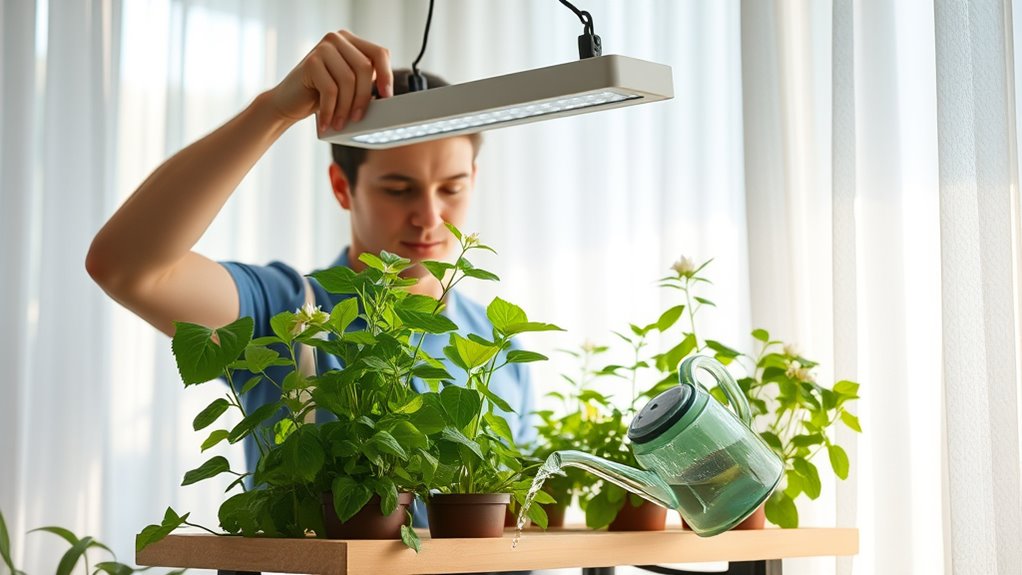
As your indoor garden moves into spring, it’s the perfect time to adjust your light and watering routines to match the changing season. To optimize growth, consider these steps:
- Shift your plants closer to windows or brighter spots as days lengthen, ensuring they receive ample light for photosynthesis.
- Gradually increase watering frequency, paying attention to soil moisture—use a moisture meter or finger test, watering only when the top inch feels dry.
- Deep watering encourages healthy root development, but always drain excess water to prevent root rot and promote new growth.
Promote New Growth With Fertilizer
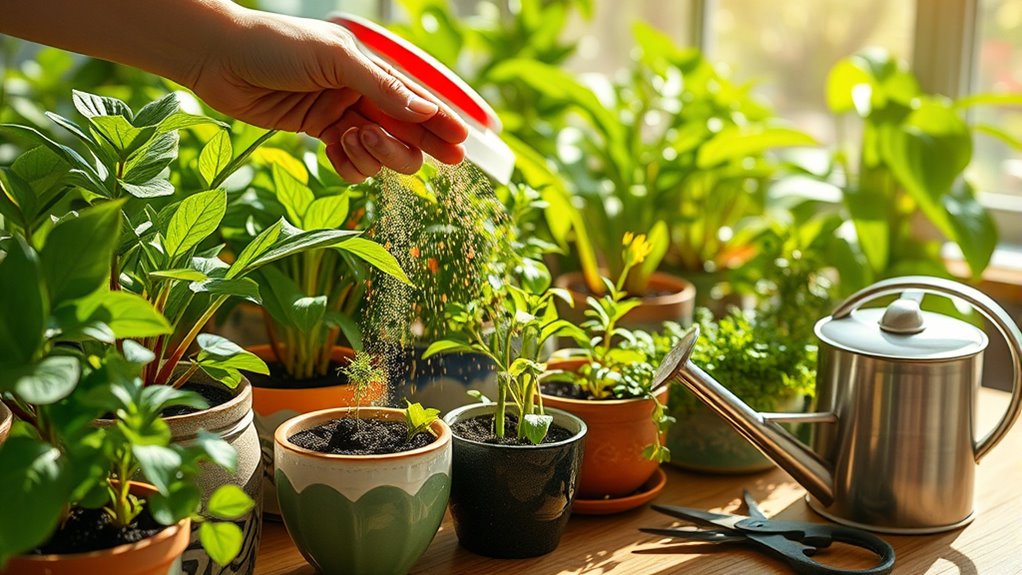
Want to give your indoor garden a boost this spring? Applying a balanced, water-soluble fertilizer at half strength provides essential nutrients like nitrogen, phosphorus, and potassium that encourage new growth in your indoor plants.
Fertilizer helps develop healthy stems, leaves, and flowers, boosting overall vitality and visual appeal. Regular feeding during the active growing season ensures your plants recover from winter dormancy and are prepared for the months ahead.
Regular fertilizing promotes healthy growth, vitality, and vibrant blooms in your indoor garden.
Using fertilizers formulated specifically for indoor plants prevents nutrient deficiencies and supports ideal photosynthesis and energy production. Timing your fertilizer application to match visible new growth maximizes nutrient uptake, resulting in a lush, healthy indoor garden.
Consistent fertilizing during spring keeps your indoor plants vibrant and thriving all season long.
Frequently Asked Questions
How Do I Clear My Garden in the Spring?
To clear your garden in spring, start by removing all dead, dried, or decayed plant material to prevent disease.
Prune overgrown or damaged stems to boost airflow and healthy growth.
Clear away fallen leaves and debris to reduce pests and mold.
Wash pots and shelves to eliminate dust and spores.
Finally, inspect your plants closely for pests or diseases and treat issues promptly to guarantee a healthy growing season.
When Should I Start Spring Garden Clean Up?
Imagine you’re in the 1800s, and now’s the perfect time to start your spring cleanup. You should begin when your plants enter active growth, typically between March and April. This aligns with longer daylight hours and increased light, helping your plants recover quickly.
Wait until after the last frost if you’re moving plants outdoors temporarily. Starting early prevents pests and diseases, setting your indoor garden up for a healthy, vibrant season.
How Do You Spring Clean Your House Fast?
To clean your house quickly, gather your supplies like microfiber cloths, all-purpose cleaner, and a duster.
Focus on high-traffic areas and visible surfaces first to make the biggest impact.
Use multi-tasking tools to save time, and keep a checklist to stay on track.
Tackle one room at a time, setting a timer to stay brisk, so you finish fast without sacrificing thoroughness.
What Is the Best Way to Clean Houseplant Leaves?
You might notice your houseplants looking dull, and it’s a perfect time to clean their leaves. Gently wipe both sides with a damp, soft cloth or sponge, being careful not to damage larger, glossy leaves—use a microfiber cloth instead.
For fuzzy or hairy leaves, a soft brush or compressed air works best. Avoid leaf shine products, as they can clog pores and hinder your plant’s health.
Conclusion
Think of your indoor garden as a thriving city. When you dust and prune, you’re clearing busy streets; rejuvenating pots is like repairing roads, ensuring smooth travel. Adjusting light and water keeps the city alive and bustling. With your care, your garden blossoms like a vibrant community, full of life and growth. Keep tending to it, and watch your indoor oasis flourish, turning your home into a lush, thriving landscape that’s always blooming.



